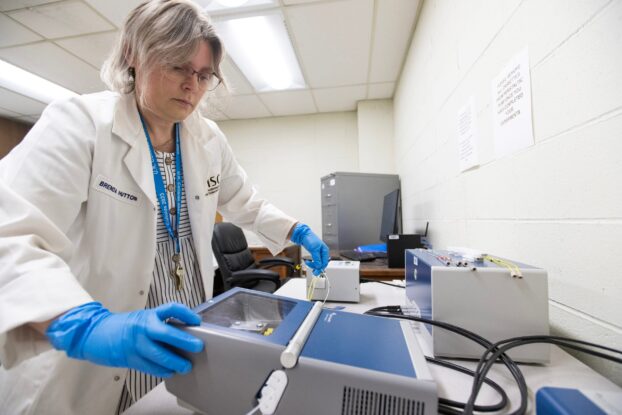Sustainable food packaging focus of UM engineering researcher
Published 12:28 pm Thursday, March 21, 2024

- Brenda Prager's research focuses on alleviating food insecurity and protecting the environment. The University of Mississippi chemical engineering professor is working with two grants to develop sustainable and protective packaging for food. Photo by Thomas Graning/Ole Miss Digital Imaging Services
By Erin Garrett
University communications
Packaging might seem like a minor detail when transporting goods, but a University of Mississippi researcher believes it could be a factor in alleviating food insecurity worldwide.
Working with two grants from the National Science Foundation and U.S. Department of Agriculture, Brenda Prager, associate professor of chemical engineering, is developing packaging materials that can better preserve food quality during transport and storage.
“I’ve always been interested in looking at food packaging and sensitive goods,” Prager said. “If we can develop ways to protect these goods, we can take major steps towards improving food security and reducing waste.”
Food that ends up in landfills each year in the U.S. could have equaled 149 billion meals. As 44 million Americans are food insecure, that number is sobering.
Prager, who is originally from Australia, often tells her graduate students two personal accounts of shipping waste when they begin working on this research.
“I first moved to the U.S. in August, so it was summer here and it was winter in Australia,” she said. “I asked my pharmacist to send my usual medication until I found a doctor here. Because it was raining in Australia, when I got the package, it was all damaged.
“I thought to myself, surely in this day and age we can protect our goods better than this. Later that year at Christmastime, it was cold here and summer in Australia. A friend sent me chocolates, and they arrived all terribly melted. What is wrong with our packaging and why is it so hard to deal with the environment? Those two stories confirmed for me why I was doing the work I was doing.”
That work involves two strategies to improve food packaging. Prager’s NSF project focuses on creating paper-based barrier coatings made from agricultural crop waste. The coatings are designed to provide moisture protection and prevent spoilage.
Typical food packaging is very prone to water damage, said Keshani Perera, an Ole Miss chemical engineering doctoral student working with Prager on the project.
“Normally the cellulose packages, or paper-based materials, are less resistant to water – they decompose in water and if it rains, the food could be ruined,” Perera said. “We are trying to improve the packages’ water resistance.
“If we have good property packaging material, we could save the food inside.”
The USDA project – a new area of research for Prager – involves a smart packaging material that can sense mechanical impacts to food during handling and transit.
Prager is working with Amanda Koh, assistant professor of chemical and biological engineering at the University of Alabama, to develop the material. Eventually, this could enable real-time monitoring of food cargo and early intervention when bruising or damage occurs.
“Goods often get damaged en route,” Prager said. “If you are transporting food like vegetables, they can get bruised and are ultimately thrown away.
“If we could know exactly when something like this is happening, we could potentially intervene and prevent mechanical damage.”
Prager said she is excited about the opportunities to advance packaging technologies toward real-world implementation.
“Food insecurity and starvation around the world is incredibly important to me,” she said. “Packaging is not the only answer, but it has been identified as one way to reduce food insecurity.”
“That’s why I’m into the idea of sustainable packaging – thinking about the environmental side – this packaging can protect the food from being damaged and then it can be recycled, which would have dual benefits.”
This material is based upon work supported by the National Science Foundation under award no. 2322501 and the U.S. Department of Agriculture under award no. 2018-67022-27972.





